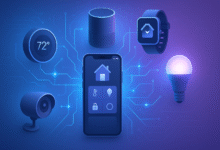Sustainable IoT Practices: Tips for Reducing Environmental Impact

Sustainable IoT Practices: Tips for Reducing Environmental Impact? Sustainable IoT practices play a pivotal role in mitigating the environmental impact of interconnected devices in our modern world. As we navigate through the intricacies of technology, it becomes increasingly crucial to prioritize sustainability in IoT deployments. With the exponential growth of IoT devices across various domains, from smart homes to industrial settings, the need for eco-friendly practices has never been more pressing. By integrating sustainability into IoT solutions, we can effectively address the challenges of resource depletion, energy consumption, and electronic waste generation associated with these devices.
In this article, we delve into sustainable IoT practices and provide actionable tips for reducing the environmental footprint of IoT deployments. From energy-efficient device design to responsible manufacturing processes, each aspect of sustainable IoT contributes to building a greener and more sustainable future. By understanding the importance of sustainability and embracing eco-friendly technologies and strategies, we can harness the power of IoT while minimizing its negative impact on the environment.
Sustainable IoT Practices
Definition and Importance of Sustainable IoT
Sustainable IoT involves deploying and using interconnected devices in a manner that minimizes their adverse effects on the environment. The goal is to balance technological advancements with environmental stewardship, ensuring that the benefits of IoT do not come at the expense of our planet.
The Need for Reducing Environmental Impact
The urgency to reduce the environmental impact of IoT arises from the substantial energy consumption, resource depletion, and electronic waste associated with these devices. By adopting sustainable practices, we can create a more responsible and environmentally conscious IoT ecosystem.
Energy-Efficient IoT Devices
In the quest for sustainable IoT, one key aspect is the development and use of energy-efficient devices.
Importance of Energy-Efficient Devices
Energy efficiency is crucial for sustainable IoT as it directly affects the carbon footprint of these devices. By optimizing power consumption, manufacturers can contribute to a greener IoT landscape.
Examples of Energy-Efficient IoT Technologies
Several energy-efficient technologies are making waves in the IoT industry. From low-power processors to advanced battery management systems, these innovations play a pivotal role in reducing energy consumption.
Materials and Manufacturing
To achieve sustainability in IoT, attention must be paid to the materials used in device manufacturing.
Sustainable Materials for IoT Devices
Choosing eco-friendly materials, such as recyclable plastics and responsibly sourced metals, can significantly reduce the environmental impact of IoT devices.
Eco-Friendly Manufacturing Processes
Manufacturers can contribute to sustainability by adopting environmentally friendly processes. This includes minimizing waste, reducing energy consumption during production, and embracing circular economy principles.
Reducing Electronic Waste
Addressing the issue of electronic waste involves designing devices with longevity in mind and implementing effective recycling programs. Sustainable IoT practices extend beyond the device’s active lifespan to its end-of-life considerations.
IoT and Renewable Energy Integration
An exciting avenue for sustainable IoT is the integration of renewable energy sources.
Utilizing Renewable Energy Sources for IoT
Solar, wind, and other renewable energy sources can power IoT devices, reducing reliance on conventional energy grids and minimizing the overall carbon footprint.
Advantages of Combining IoT with Renewable Energy
Beyond environmental benefits, integrating IoT with renewable energy sources enhances reliability and resilience. Devices can operate in remote locations or during power outages, contributing to overall system sustainability.
Data Management and Storage Solutions
Efficient data management is pivotal for sustainable IoT, addressing both environmental and operational concerns.
Efficient Data Storage Practices
Optimizing data storage reduces the need for large-scale data centers, minimizing energy consumption and environmental impact.
Cloud-Based Solutions and Their Impact
Cloud computing offers scalable and energy-efficient solutions for storing and processing IoT-generated data. However, careful consideration is required to ensure sustainability in cloud infrastructure.
Reducing Data Redundancy and Unnecessary Storage
By implementing smart data management strategies, IoT users and providers can minimize redundancy, ensuring that only essential data is stored, reducing storage requirements and associated environmental costs.
Regulatory Compliance in IoT
Ensuring sustainable practices in the IoT industry requires regulatory frameworks and industry standards.
Current Regulations and Standards
Governments and international organizations play a crucial role in establishing and enforcing regulations that promote sustainable IoT practices. Compliance with these standards is vital for industry players.
The Role of Governments and Organizations
Governments and industry organizations should collaborate to develop comprehensive policies that encourage sustainability without stifling innovation. This collaboration is essential for creating a balanced regulatory environment.
Encouraging Adherence to Eco-Friendly Practices
In addition to regulations, initiatives that promote and reward eco-friendly practices can encourage businesses to adopt sustainable IoT strategies voluntarily.
Innovation and Sustainable IoT
The future of sustainable IoT lies in continued innovation and collaboration among industry players.
Emerging Technologies for Environmental Conservation
Innovative technologies, such as AI-driven energy optimization and eco-friendly materials, are shaping the future of sustainable IoT.
Collaborative Efforts in Research and Development
Collaboration between research institutions, businesses, and governments is essential for driving innovation in sustainable IoT practices.
Encouraging Innovation in the Industry
Recognizing and rewarding innovative solutions that contribute to sustainability can inspire further advancements in the IoT industry.
Challenges in Implementing Sustainable IoT
While the goals of sustainable IoT are clear, several challenges must be addressed for widespread adoption.
Economic Challenges
Implementing sustainable practices can come with initial costs. However, the long-term benefits, both environmental and economic, often outweigh these initial investments.
Technological Barriers
Developing energy-efficient and sustainable IoT technologies requires overcoming technical challenges. Ongoing research and development efforts are crucial for finding viable solutions.
Balancing Sustainability and Functionality
Finding a balance between sustainable practices and the functionality expected from IoT devices poses a challenge. Striking this balance is essential for ensuring user satisfaction and adoption.
Success Stories in Sustainable IoT
Acknowledging companies that lead in sustainable IoT practices provides inspiration and guidance for the industry.
Companies Leading in Eco-Friendly IoT Practices
Highlighting success stories of companies prioritizing sustainability helps create a positive narrative and sets benchmarks for others to follow.
Recognizing Achievements and Contributions
Publicly acknowledging and celebrating achievements in sustainable IoT encourages healthy competition and motivates others to adopt similar practices.
Case Studies Illustrating Positive Outcomes
Examining specific case studies that showcase positive environmental outcomes from sustainable IoT implementations helps build confidence in adopting these practices.
Future Trends in Sustainable IoT
The trajectory of sustainable IoT points towards continuous improvement and evolution.
Predictions for the Future of Eco-Friendly IoT
Experts predict that future IoT devices will be even more energy-efficient, leveraging advanced technologies to minimize their environmental impact.
Technological Advancements on the Horizon
Anticipated advancements in materials, energy storage, and communication technologies will contribute to more sustainable IoT solutions.
Anticipated Improvements in Environmental Impact
As the industry matures, ongoing efforts are expected to yield more significant improvements in reducing the overall environmental impact of IoT devices.
Read More: Creating a Secure IoT Network: Tips for Home and Business In 2024
Conclusion
What is sustainable IoT?
Sustainable IoT involves deploying and using interconnected devices in a manner that minimizes their adverse effects on the environment.
How can consumers contribute to sustainable IoT practices?
Informed consumer choices, supporting eco-friendly certifications, and demanding sustainability from manufacturers contribute to sustainable IoT practices.
Are there any specific regulations for eco-friendly IoT?
Governments and international organizations are working on regulations to promote sustainable IoT practices, ensuring compliance within the industry.
Can sustainable IoT be cost-effective for businesses?
While there may be initial costs, the long-term benefits, both environmental and economic, often outweigh the investment in sustainable IoT practices.
How can innovation drive sustainability in the IoT industry?
Innovation, collaboration, and recognition of achievements in sustainable IoT practices inspire further advancements and contribute to the industry’s overall sustainability.











